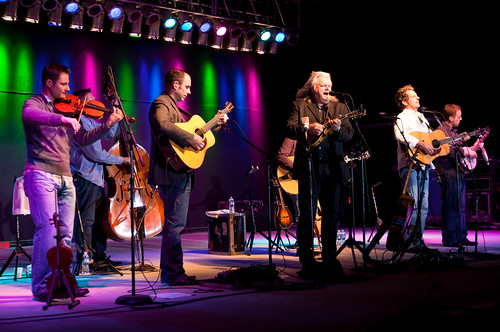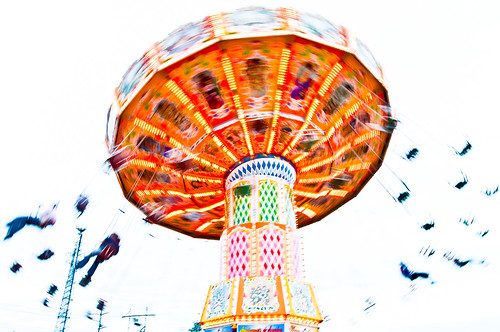F**k Auto

So you went out and bought a fancy DSLR camera, or possibly one of those newfangled micro four-thirds cameras with interchangeable lenses because you’ve decided that you want to upgrade the photos you make by getting a better camera. You slap on the lens, pop in a memory card and then start taking pictures. Then the buyer’s remorse sets in because the photos don’t look all that much better than the ones on your little Kodak point-and-shoot! What happened? Well, like most people who own a camera, you left the camera in auto mode and expected it to interpret the photos you see in your mind into the photos that show up on your computer. Unfortunately, it doesn’t usually work out that way. Taking better photographs involves much more than an expensive camera. It involves a bit of knowledge, a dash of skill, and an eye for composition – none of which a camera can accomplish on its own. Let’s talk about making the switch away from auto mode.
Take a good look at the photo at the top of this post. That’s 14 time Grammy Award winner Ricky Skaggs and his band. There they are up on stage, acoustic instruments in their hands, singing their hearts out – these guys don’t know the meaning of “Auto”. I bet they all drive using manual transmission. You might not like bluegrass, but you can get the metaphor. I took this shot at the fair this past Tuesday. Here’s the camera info for this shot: I used my Tamron 17-50mm lens at 35mm, at 1/125 of a second with a f/4 aperture and ISO 800. I set this up manually on my camera during his first number and pretty much used the same settings for the rest of the shots I took of them.
Do you see all that negative space in the top and bottom right corners? Auto hate’s that. Auto is prejudiced against darkness. I hate prejudice, hence the harsh title of this post. If I took that shot and let Auto drive, the damn flash would have popped up so fast and punched this band right in the face with awful direct light that they probably would have stopped playing and kicked the camera out of my hands (well, not really, considering the amount of fans that were shooting pictures with their flashes on, illuminating only the back of the head of the person in front of them). Do you see all the color on the back of the stage? Auto wouldn’t. It would have blown that right off the photo. Auto is a dick. It only cares about the closest thing it can focus on. The rest of the scene is meaningless to Auto. Color? Dynamic range? Contrast? These are all enemies of Auto, yet they are some of the most important aspects of a good photo.
OK, so now you have a good reason to hate Auto, what are you going to do about it? You really need to learn about exposure and there are books on the subject, or you can google it and find a lot of really great articles on the subject, so go ahead – I’ll still be here when you’re done. Once you know what exposure is, you need to understand the basic relationship between the amount of light you let into the camera (aperture), the length of time you let that light in for (shutter speed), and the sensitivity of the sensor that captures it (ISO). It doesn’t have to be a geeky math nerd understanding, but at least an understanding of the aesthetic effect that those three factors have on your photography.
I know what you’re thinking – how am I supposed to capture a great moment and be expected to figure out what ISO setting to be on, what aperture to use, and what the proper shutter speed should be? By the time I flick one dial the moment has passed! Well, most cameras come with really good training wheels! There’s “Program Auto” mode (or P Mode), which lets you control the ISO, the flash, and the white balance, but it still chooses the aperture and shutter speed. P Mode still sucks, but it’s a start. I prefer “Aperture Priority” and “Shutter Priority” modes. They allow you to have control of the same things P Mode does, but you can either set the aperture if in A Mode and let the camera pick the best shutter speed based on the aperture you choose, or the shutter speed in S Mode which lets the camera pick the best aperture based on your shutter speed. You can also set the ISO, or program an auto ISO range when using one of these modes, so that you can limit the amount of possible digital noise in your photos. In a lot of situations, you can leave the white balance setting in auto WB as well, as it does a pretty good job of setting itself. In situations where you are using multiple light sources or there are extreme colors you want to enhance or diminish, then manually setting the white balance is a good idea. Some other settings you can manipulate in these modes are the type of metering and the exposure compensation. Both of these settings let you trick the camera’s built-in light meter into doing what you want – further giving you control of your vision. If you find yourself messing with the metering and exposure values a lot, you need to just shoot in manual and compensate with your shutter speed and/or aperture!
I realize that there is a lot to understand here and I’m just giving you a basic overview, but with time these things become second nature. I still spend a lot of time in aperture priority mode, because I like to control the depth of field in my work, and it usually serves me well in a pinch. Lately though, I’ve been making a conscious effort to hang out in manual mode and it has allowed me to do creative things much easier and more consistently than in A mode. When I recently did a series of portraits for a Halloween party, I set the camera manually to create consistent low-key exposures:
If I had used A mode, even if I were to adjust the exposure compensation, each shot would meter differently because of the color of their costumes and how the meter would read them. In manual mode, each photo will be exposed the same way. Another example is taking high-key photos like this one:

In any other mode but manual, the camera would try to “fix” this shot because it’s deliberately over-exposed. Shooting in manual lets me further realize the images I want to create. This allows for artistic control – you are the one making the shot, not the camera. This is why when a photographer is told that they “must have a nice camera” when someone comments on one of their photos, they get pretty steamed! The camera would have screwed it up if it was in control!!
I don’t usually dabble into the how-to realm on this site, but I think it’s important that people understand how much work goes into making a photograph, and while I think it’s even more important to share the “why”, understanding the “how” lets the reader appreciate the “why” all the more. Now you know why I hate Auto and have a better understanding of how to stop using it, so go out and make some shots in M mode and further realize your artistic vision.
Pingback: Tweets that mention F**k Auto | JWNPhoto.com -- Topsy.com
Pingback: Photo Book Recommendations | JWNPhoto
Pingback: Grandparents Day | JWNPhoto